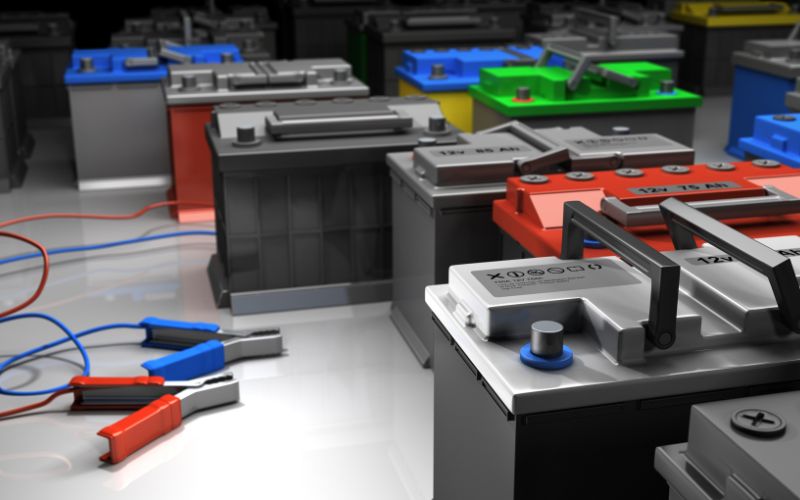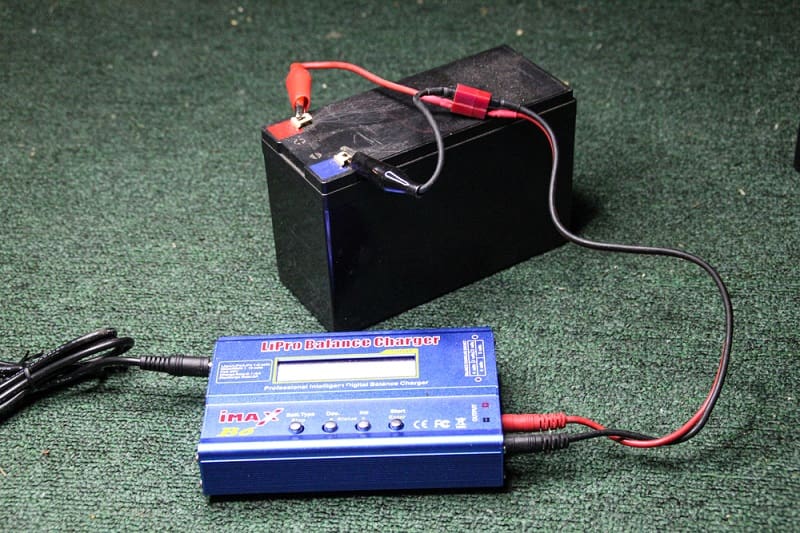You just bought a new deep cycle battery to power your trolling motor or boat accessories. After a long day on the water, you need to recharge it.
How do you do that?
Specifically, what amperage should you set the charger at? What amperage is recommended for deep cycle batteries, and how long will each recharge take?
Keep reading!
In this article, we’ll answer all of these questions and more!
Table of Contents
Recommended Amperage to Charge a Deep Cycle Battery
There are two main kinds of batteries: starting and deep cycle.
Starting batteries supply a quick burst of power to get your engine running, then they are continuously recharged by the motor’s alternator. These batteries are commonly found in cars and used to start outboard motors.

Deep cycle batteries provide lower levels of power over much longer periods of time. These batteries can be deeply discharged over and over again as they power your trolling motor, boat accessories, and fishfinders.

Deep cycle batteries are quite different from starting batteries. For this reason, they require a different charging amperage. Because they are designed to discharge slowly, deep cycle batteries must also be recharged slowly.
It is recommended to charge your deep cycle battery at between 5 and 15 amps, though it’s okay to charge at lower amperages as well.
What’s more, the best way to charge a deep cycle battery is in stages. For best results and to avoid the risk of damaging your battery, use an automatic charger specifically designed for deep cycle batteries. These types of chargers are known as float chargers.

The charging stages of a float charger are as follows:
- Bulk charging: When you first hook the charger up to your battery, it will supply a greater number of amps–as much as 10 to 15 per hour. This relatively fast charging rate will continue until the battery has reached about 80 percent capacity.
- Absorption charging: When the battery is at 80 percent, the charger will automatically reduce the amp output. It will continue to supply this steady but decreased amount of power until the battery reaches about 90 to 95 percent capacity.
- Float charging: At this point, the charger’s output will continuously diminish as the battery nears a full charge. This reduces the risk of overcharging. Once a full charge is reached, the charger will turn itself off or switch into maintenance mode.
These chargers are great because you don’t have to monitor them. That said, you may need to program them initially for the type of battery you have (flooded, AGM, or gel) and the maximum number of amps you want them to charge at during the bulk charging stage.
Though the recommended range of amps is between 5 and 15 per hour, it’s important to take your individual battery into consideration.
For example, if you have a small 35 amp-hour deep cycle battery, and it is only about 40 to 50 percent discharged, it may be better to recharge it at a lower rate–between 2 and 5 amps per hour during the bulk stage. This will lower the risk of overcharging.
On the other hand, if you have a large 100 amp-hour battery that is 80 percent discharged, recharging it at a rate of 2 to 5 amps per hour will take forever. In this case, it would be better to charge the battery at a rate of 10 to 15 amps per hour during the bulk stage.
How Long Does It Take to Charge a Deep Cycle Battery at Different Amperages?

The short answer is, it depends on many factors. The table below, courtesy of Sport Fishing Buddy, should give you a rough idea of what to expect when charging at different amperages:
| Battery Reserve Capacity | 2 Amp Charger | 4 Amp Charger | 6 Amp Charger | 10 Amp Charger | 15 Amp Charger |
| 80 RC | 17.5 hours | 8.5 hours | 6 hours | 3.5 hours | 2.5 hours |
| 140 RC | 27 hours | 13.5 hours | 9 hours | 5.5 hours | 3.5 hours |
| 160 RC | 30 hours | 15 hours | 10 hours | 6 hours | 4 hours |
| 180 RC | 33 hours | 16.5 hours | 11 hours | 6.5 hours | 4.5 hours |
The information in this table gives you an idea of how charging times change when charging the same battery at different amperages.
Remember, though, these are only rough estimates. The actual amount of time it takes to charge your battery will vary depending on a variety of factors, including:
- Size of battery: Larger batteries take longer to recharge than smaller batteries. If you had a 100 amp-hour battery and a 25 amp-hour battery, and both were 50 percent discharged, it would take much longer to charge the hundred-amp-hour battery to full capacity.
- Age of battery: Older batteries generally take longer to recharge than newer batteries. They also discharge more quickly, which will necessitate more frequent charges.
- Condition of battery: Regardless of age, a battery will take longer to recharge if it is in poor condition. A 5-year-old battery that has been well maintained will perform better and will not take as long to charge as a one-year old battery that has been damaged and abused.
- Ambient temperature: Extreme cold and heat affects not only charging time but charging amperage as well. On cold days, you’ll need to use a higher amperage to recharge your battery. For this reason, it’s a good idea to buy a charger with built-in temperature compensation .
Should I Charge My Battery Slow Or Fast?

It is always better to err on the side of caution when it comes to charging your deep-cycle batteries.
As mentioned above, deep cycle batteries discharge slowly, so they need to recharge relatively slowly as well.
So, it’s best to charge your battery slow, at a lower amperage. The higher the amperage you use, the greater your chances of overcharging the battery, which can cause damage from overheating.
What’s more, a slow charge will allow you to get the most out of your battery life. Repeated fast charges, even if they don’t damage your battery, will gradually cause wear and tear that, in turn, may cause it to fail before its time.
You should never charge your deep cycle battery at more than 15 amps per hour. Again, for the best results, use an automatic charger with three-stage charging and temperature compensation.
Conclusion
In general, deep cycle batteries should be charged at between 5 and 15 amps per hour, though it’s okay to choose a slower rate as well (between 2 and 5 amps per hour).
It is better to charge these batteries slowly, as charging too fast can cause them to overheat and become damaged.

Sarah Hood has been writing for Anchor Travel since 2021. When she’s not writing, she enjoys cooking, singing, and spending time in the great outdoors.

